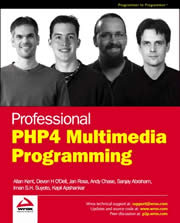
Authors: Devon H O’Dell, Andy Chase, Jan Rosa, Sanjay Abraham, Allan Kent, Iman S.H. Suyoto, Kapil Apshankar
One of the many bonuses of using PHP is that it’s open source. There are plenty of developers who have found new and creative ways to extend PHP past its previous “limitations”.
With the latest version of PHP and its extensions, we are able to manipulate images, create PDFs, and even create Flash files.
Professional PHP4 Multimedia Programming seeks to be a reference guide for the multimedia aspects of PHP. Giving installation instructions, detailed documentation, in-depth tutorials, and case studies, this book offers a plethora of information on using PHP with GD, ImageMagick, Ming, and PDFlib.
These extensions of PHP become profitable for developers by giving them the ability to build image libraries, dynamically output Flash files, and produce PDF reports. The only problem is there is not nearly enough documentation available for projects like these. That’s why I was very interested in this book.
From the Basics to Everything Else
Just like every programming book before it, Professional PHP4 Multimedia Programming starts at the beginning by explaining what PHP is and is not. The book also gives step-by-step instructions on installing PHP and the extensions in the event they are not already installed on your server. To help with the installations, troubleshooting tips and ways to test the installations’ success are also given.
But that is only a small part of the book.
The book goes on to cover each of the multimedia pieces of PHP by explaining what they can be used for and then picking all the extensions apart. This book is definitely for those who are already familiar with PHP and are ready to move to the next level.
Case Studies
About two thirds of the book covers the basics on using the extensions. The rest is dedicated to case studies and reference. I found most of the case studies to be practical including an image gallery utilizing ImageMagick and a PDF Template system. These are real-life systems that developers work on everyday.
The reference section of the book will always come in handy as it gives quick descriptions to all the different tags, methods, arguments, etc. of the extensions.
The only problem I had with the book is each one of these extensions could have a full book written about them. So while the book gives a good overview of each extension, this book is certainly not the “end all” of multimedia programming in PHP.
With that said, this is a great start and as I continue down this lightly documented path, I will keep this book handy on my journey. You should too.
—
Scott Manning started a web development shop three years ago after discovering his propensity for usability-oriented design. Sticking with the straightforward name Scottmanning.com, his vision has resulted in the company becoming an indispensable part of the international Flash community. As a successful freelance developer and small business owner, Scott noticed the lack of quality materials available for this growing sector of the market, and began writing articles based on his experiences. Scott has also devoted an increasing amount of time to coaching newcomers in the industry.








